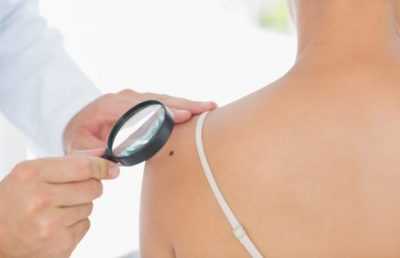Mole Removal
What Can You do About Your Moles?

Three Different Types of Moles
Most moles are benign or non-cancerous. It’s very common to have several moles on your body.
Here are three common mole types:
- Skin Tags
These are small growths that generally form because of friction. They are usually found on places like the collar bone or under the arm where clothes rub against the area. They are usually skin-colored but may also be darker in color. - Flat Moles
A flat mole is considered to be a dark spot or irregularity in the skin. - Raised Moles
These moles can be a variety of colors. They run deeper into the dermal layers of the skin than flat moles.
The A, B, C’s of Suspicious Moles
Most moles aren’t anything to worry about. But you should be aware of the moles you have in case they change. If a mole suddenly changes color or shape, then you should have a dermatologist look at it. Also, pay close attention to any moles that may bleed, ooze, itch, appear scaly, or that become painful. These are also signs that you should see a doctor about your mole.
Here are the A,B,C’s to consider when questioning about your moles:
- Asymmetry – Does half of your mole not match the other half?
- Border – Are the edges or borders of your mole ragged, blurred, or irregular?
- Color – Is the shade the same throughout? Are there shades of tan, brown, black, blue, white, or red?
- Diameter – Is the size larger than an eraser on a pencil?
- Evolving – Is the size, shape, or color changing?
When to be Concerned?
Moles don’t typically cause serious health concerns, but they need to be monitored for melanoma. If you have any of the changes in the A, B, C’s we listed above, then you should contact the dermatologist to have the mole examined.
The American Academy of Dermatology says that if you have more than fifty common moles, or at least several atypical moles, then you should perform a monthly self-examine and see a dermatologist at least once a year.
Mole Diagnosis
Your doctor will identify the type of mole you have by examining your skin. During the exam, your doctor will inspect your skin from head to toe. If your doctor thinks a mole may be cancerous, then they may take a biopsy to examine the tissue under the microscope.
There are three main types of skin biopsies:
- Shave biopsy – A tool similar to a razor will take off the top layer of the skin.
- Punch biopsy – A doctor will use a circular tool to remove a small section of the skin. This will remove some of the deeper levels.
- Excisional biopsy – A doctor will use a small knife to remove the entire lump or area.
Related Pages
- Treatment for Flaky Facial Skin from Dandruff and Rosacea
- Glytone
- Avene
- Microblading vs. Eyebrow Tattooing: What’s the Difference, and Why Does it Matter?
- Forehead Botox: Everything You Need to Know about the Cost, Risks, and Benefits
- Bellafill: A Long-Lasting, Effective Dermal Filler Solution
- Sebaceous Hyperplasia: Causes, Symptoms, and Treatment
- Laser Hair Removal: The Superior Alternative
- Neuromodulation
- Neck Lift
- Crepey Skin Treatment
- Wrinkle Treatment
- Molluscum
- Seborrheic Keratosis
- Mole Removal
- Actinic Keratosis
- Contact Dermatitis
- Itchy Scalp Treatment
- Atypical Nevi
- Hyperhidrosis Treatment
- Melasma Treatment
- Cysts Treatment
- Psoriasis
- Warts Treatment
- Eczema Treatment
- Seborrheic Dermatitis Treatment
- Rosacea Treatment
- Fungal Infections
- Hair Loss Treatment
- Acne Treatment
Quick Quote
Procedures for Mole Removal
You can typically have a mole removal on the face or another part of the body during a quick outpatient procedure. A local anesthesia will be used to numb the area before the mole is removed. Keep in mind, a mole removal scar may appear and end up being permanent.
These are the three-mole removal procedures used:
- Shave Excision
This process is used to shave several layers of the mole off so that it is down to the surface of the skin. A dermal loop electrode may also be used during this procedure to feather the edges to prevent future scarring. This mole removal cost is up to $500 and causes very little, if any, downtime. - Punch Excision
This is used to remove moles that are deeper than the surface of the skin. The device will punch a hole into the skin to penetrate below the mole. The circular part of the skin is taken out, and the hole is sutured and bandaged. This will only work on moles no more than 8 mm in diameter. - Surgical Excision
A mole that is greater than 8 mm will need this procedure. This is the most invasive type of mole removal procedure and is used to remove moles with irregular borders that penetrate deep into the skin.
Benefits of Removing Your Mole
There are several benefits to having your mole removed. You will have better cosmetic results, more confidence in your appearance, be more comfortable in your clothing without having to worry about a mole rubbing, and just have an overall peace-of-mind knowing the lesion is gone.
Keep in mind, if you’re removing a mole for cosmetic reasons, insurance may not pay for it. If the mole is being removed because it looks suspicious, insurance may cover at least a portion of the procedure.
Get Your Pesky Moles Removed at Winston Salem Dermatology
If you are ready to have your mole removed, then we are ready to help you! We are your specialists in skincare. Call us today so we can examine your mole and figure out the laser mole removal or other dermatology services for removal options that are available. We will work hard to make sure you have smooth, even skin in no time. Call us at (336) 774-8636
Related Pages
- Treatment for Flaky Facial Skin from Dandruff and Rosacea
- Glytone
- Avene
- Microblading vs. Eyebrow Tattooing: What’s the Difference, and Why Does it Matter?
- Forehead Botox: Everything You Need to Know about the Cost, Risks, and Benefits
- Bellafill: A Long-Lasting, Effective Dermal Filler Solution
- Sebaceous Hyperplasia: Causes, Symptoms, and Treatment
- Laser Hair Removal: The Superior Alternative
- Neuromodulation
- Neck Lift
- Crepey Skin Treatment
- Wrinkle Treatment
- Molluscum
- Seborrheic Keratosis
- Mole Removal
- Actinic Keratosis
- Contact Dermatitis
- Itchy Scalp Treatment
- Atypical Nevi
- Hyperhidrosis Treatment
- Melasma Treatment
- Cysts Treatment
- Psoriasis
- Warts Treatment
- Eczema Treatment
- Seborrheic Dermatitis Treatment
- Rosacea Treatment
- Fungal Infections
- Hair Loss Treatment
- Acne Treatment
Quick Quote
Address
Winston Salem Dermatology & Surgery Center
1400 Westgate Center Drive,
Suite 200 - Winston Salem, NC 27103
Phone: 336.774.8636
Fax: 336.774.0265
www.WinstonSalemDermatology.com

Pay Here


Quick Links
Review
Dermatology Services
Cosmetic Skin Care
Skin Cancer Treatment
Blog
Contact
Infographics
Hypopigmentation Treatment
Neuromodulation
